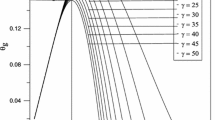Abstract
We investigate the explosion-induced ignition and combustion of an acetylene cloud in a rectangular chamber (\(10\,\hbox {cm}\times 10\,\hbox {cm} \times 39\,\hbox {cm}\)). In the experiments, a 0.2-g PETN charge was located at \(x = 9.7\,\hbox {cm}\) and a soap bubble (\(d = 5\,\hbox {cm}\)) filled with pure acetylene was located at \(x= 27\,\hbox {cm}\) as measured relative to the end wall. Detonation of the charge created a blast wave that crushed the soap bubble—inducing mixing with the air. After 0.55 ms, the mixture ignited, forming at turbulent combustion cloud. The flow was modeled using the compressible Navier–Stokes equations assuming unity Lewis number. Arrhenius-based kinetics were used to model ignition. Adaptive mesh refinement was used to capture turbulent mixing on the grid (the MILES approach of J. Boris). Computed pressures were found to be in agreement with measured pressure histories. Finite-rate kinetics were required to capture the ignition processes over the duration of the experiment.









Similar content being viewed by others
References
Bjerketvedt, D., Bakke, J., van Wingerden, K.: Gas explosion handbook. J. Hazard. Mater. 52, 1–150 (1997). https://doi.org/10.1016/S0304-3894(97)81620-2
Diegelmann, F., Hickel, S., Adams, N.A.: Three-dimensional reacting shock–bubble interaction. Combust. Flame 181, 1339–1351 (2017). https://doi.org/10.1016/j.combustflame.2017.03.026
Kuhl, A.L., Reichenbach, H.: Combustion effects in confined explosions. Proc. Combust. Inst. 32(2), 2291–2298 (2009). https://doi.org/10.1016/j.proci.2008.05.001
Kuhl, A.L., Reichenbach, H.: Barometric calorimeters. Russ. J. Phys. Chem. B 4(2), 271–278 (2010). https://doi.org/10.1134/S1990793110020132
Kuhl, A.L., Bell, J.B., Beckner, V.E., Balakrishnan, K., Aspden, A.J.: Spherical combustion clouds in explosions. Shock Waves 23(3), 233–249 (2013). https://doi.org/10.1007/s00193-012-0410-y
Kuhl, A.L., Bell, J.B., Beckner, V.E., Reichenbach, H.: Gasdynamic model of turbulent combustion in TNT explosions. Proc. Combust. Inst. 33, 2117–2185 (2011). https://doi.org/10.1016/j.proci.2010.07.085
Bell, J., Day, M.: Adaptive methods for simulation of turbulent combustion. In: Echekki, T., Mastourakos, E. (eds.) Turbulent Combustion Modeling. Fluid Mechanics and Its Applications, vol. 95, pp. 301–329. Springer (2011). https://doi.org/10.1007/978-94-007-0412-1_13
Bell, J.B.: AMR for low Mach number reacting flow. In: Barth, T., Griebel, M., Keyes, D., Nieminen, R., Roose, D., Schlick, T. (eds.) Proceedings of the Chicago Workshop on Adaptive Mesh Refinement Methods, Lecture Notes in Computational Science and Engineering, pp. 203–221 (2012)
Kazakov, A., Frenklach, M.: Reduced Reaction Sets based on GRI-Mech 1.2 http://combustion.berkeley.edu/drm/
Daly, D., Nag, P.: Combustion modeling of soot reduction in diesel and alternate fuels using CHEMKIN®. SAE Technical Paper 2001-01-1239 (2001). https://doi.org/10.4271/2001-01-1239
Brown, P.N., Byrne, G.D., Hindmarsh, A.C.: VODE: a variable-coefficient ODE solver. SIAM J. Sci. Stat. Comput. 10(5), 1038–1051 (1989). https://doi.org/10.1137/0910062
Boris, J.P.: On large eddy simulation using sub-grid turbulence models-Comment 1. In: Lumley, J.L. (ed.) Whither Turbulence? Turbulence at the Crossroads. Lecture Notes in Physics, vol. 357, pp. 344–353. Springer, Berlin (1989). https://doi.org/10.1007/3-540-52535-1_53
Acknowledgements
Lawrence Livermore National Laboratory is operated by Lawrence Livermore National Security, LLC, for the U.S. Department of Energy, National Nuclear Security Administration under Contract DE-AC52-07NA27344. LLNL-TR-745431.
Author information
Authors and Affiliations
Corresponding author
Additional information
Communicated by G. Ciccarelli.
Publisher's Note
Springer Nature remains neutral with regard to jurisdictional claims in published maps and institutional affiliations.
H. Reichenbach: Requiescat in pace (28 October 2017).
Rights and permissions
About this article
Cite this article
Kuhl, A.L., Reichenbach, H., Bell, J.B. et al. Explosion-induced ignition and combustion of acetylene clouds. Shock Waves 28, 1031–1037 (2018). https://doi.org/10.1007/s00193-018-0843-z
Received:
Revised:
Accepted:
Published:
Issue Date:
DOI: https://doi.org/10.1007/s00193-018-0843-z



